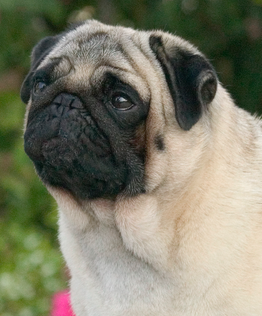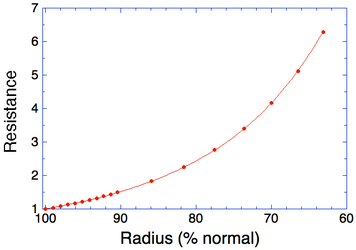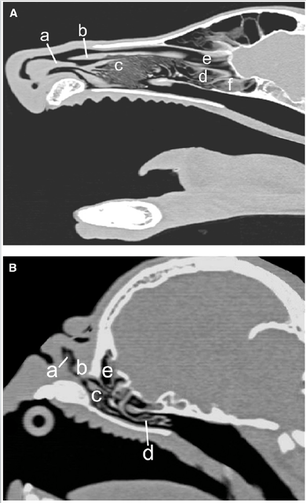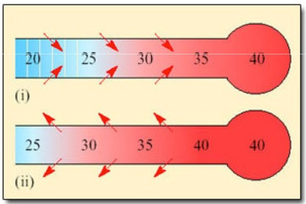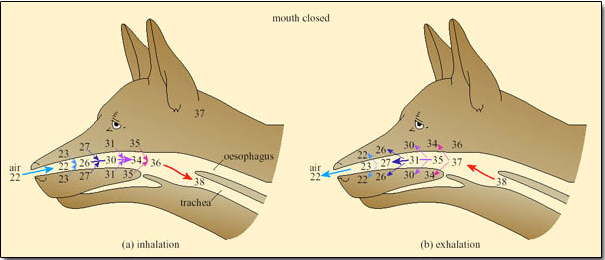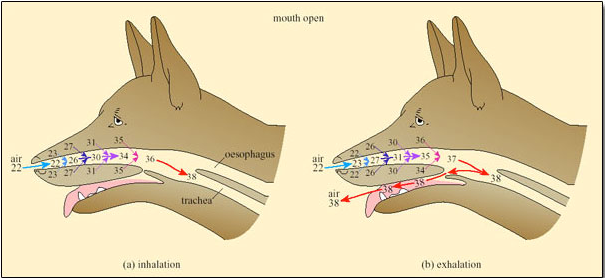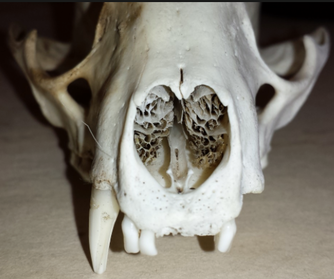|
By Carol Beuchat PhD A paper just out this week (Packer et al 2015) has highlighted the increasing concern about the physiological problems associated with canine brachycephaly, the foreshortened muzzle characteristic of “flat-faced” breeds like the Pug, Bulldog, French Bulldog, Chin, Brussels Griffon, Pekingese, and others. In these breeds, the bony structure of the skull has been altered through selective breeding to reduce the length of the muzzle. However, the soft tissues of the muzzle have not been similarly reduced (Packard & Tivers 2015). The result is Brachycephalic Obstructive Airway Syndrome (BOAS).
The first step in this sequence is inhalation of external air into the nostrils. The openings of the nostrils must be large enough to permit inhalation with minimal resistance. What happens if the opening of the nostril is reduced, as it is in a dog with stenotic nares? Air has many of the same properties as a liquid. One of these is resistance to flow through tubes because of friction. To draw air into the lung, the negative pressure produced by the diaphragm must be great enough to overcome the resistance to flow through the airways from nostril to lung. You can see in the photo above the wide variation in the size and shape of the nostrils in a sample of dogs. Some are round and wide, while some are pinched almost entirely closed. These differences in structure will affect the effort it takes to inhale The resistance to flow is exquisitely sensitive to the diameter of the tube the air must travel through. This is because resistance (R) is inversely proportional to the radius of the tube (r) raised to the 4th power. This means that a relatively small change in radius can result in a large change in resistance: a tiny increase in the radius of a tube can substantially reduce resistance to flow, and by the same token a tiny reduction can dramatically increase it. This point is key, but instead of calling the geek squad to translate, let’s see if we can make it clear with a simple graph.
(Note here that we’re treating the opening of the nostril as if it is a simple circular tube when in fact it is more complicated than that, but the principles remain the same.)
If we continue to reduce the radius of the nares, you can see that when the radius is reduced to 80% of normal, the resistance has more than doubled (R is about 2.3), and at 70% of normal the resistance is 4X (!) greater than normal.
Is this really that big a deal? Would you even notice a 10% difference in the size of the nostrils of two dogs? Try this. Pinch your nostrils ever-so-slightly; in fact, don’t pinch the nostrils but just the fleshy end of your nose above the nostrils. Inhale and exhale. Now imagine how this would affect you if you were doing something that required some mild exertion. Would you notice the difference? Try pinching a bit more, and keep breathing. At some point, you feel compelled to open your mouth to breathe. This feeling that you’re not getting enough air is called dyspnea, and it is caused by the rising level of carbon dioxide in your blood (cyanosis). The reason this feels so uncomfortable is because in order to overcome the resistance caused by the reduced opening of the nostrils, you need to create a larger negative pressure in your thoracic cavity. This takes significantly more effort and is not something you would want to put up with routinely. (Remember your last head cold?)
The problems brachycephaly causes with breathing are relatively easy to understand. We can imagine the problems that might result from squeezing the contents of the muzzle into a much smaller space. And we can appreciate how uncomfortable it might be. Again, think about your last head cold.
Shortened Muzzle
But there’s another, and potentially far more serious, consequence of the shortening of the muzzle in the brachycephalic breeds.
When the air is exhaled, it travels back through these passages, and as the tissues get progressively cooler down the length of the muzzle, heat is reabsorbed back into the body so that the air that is exhaled is at a lower temperature than it was in the lungs.
This is called a counter-current heat exchanger, and it helps the dog conserve body heat. The longer the muzzle of the dog, the more effective it is. Dogs and all mammals keep their body temperature high by generating metabolic heat, which requires energy. Minimizing heat lost by respiration reduces the energy requirements of the dog. The picture below illustrates this heat conservation system of the dog when the mouth is closed. (Here they have the dog’s body temperature at 38 C and the outside air at 22 C). The cool outside air is warmed as it travels through the passageways of the muzzle when the dog inhales, and the air from the lungs warms the tissues that it passes across during exhalation. When a dog becomes overheated, as for example when exercising, it will pant. Air is inhaled as before, warming as it travels to the lungs, but now it is exhaled through the mouth. The heat content of the air is not returned to the tissues of the nose but is dumped in a lungful of hot air. With every breath, the dog is inhaling cooler air and exhaling it at body temperature. As the air passes over the moist tissues of the mouth and the tongue (which is likely to be hanging out), evaporation will cool these surfaces and this also helps to reduce body temperature.
But what happens when it’s hot outside?
This system works great when it’s cold outside, but it’s not so handy in a hot environment when the dog would rather dump heat than conserve it. You have probably heard that the muzzle of the dog is important for cooling. In fact, the mechanism for this is a clever modification of the system we just described for conserving heat.We mentioned the turbinates above, which are the complex, membrane-lined maze of passages in the muzzle through which air must flow on the way to the trachea. In fact, the turbinates play a key role in keeping a dog from overheating on a warm day.
So here’s the critical scenario when it’s hot outside. Warm external air picks up water from the moist membranes of the turbinates during inhalation, which cools the tissues and therefore the blood in the capillaries, and this in turn helps reduce the temperature in the brain and body core. For this cooling system to work, evaporation of water from the turbinates is essential! So what’s the problem in brachycephalic breeds? For both heat conservation and cooling, the length of the muzzle is key. When it’s cold out, heat is recovered from exhaled air as it travels down the length of the muzzle to the nose. The shorter the muzzle, the less the temperature gradient between the body and the tip of the nose, so less heat will be recovered and more heat will be lost in exhaled air. The other issue is that when the turbinates are compressed to fit in a smaller space, the size of the passageways is reduced, which increases resistance to airflow as we saw above, or the passageways can be eliminated entirely if adjacent walls touch (Schuenemann & Oechtering 2014). This will reduce heat recovery on cool days, which means the animal will have to waste energy to generate more heat metabolically. When it’s hot, the large, moist surfaces of the turbinates are critical for the evaporative cooling that reduces blood temperature before it flows to the brain. If the function of the turbinates is compromised because the passageways are narrower or even blocked, the dog has no means to prevent its body temperature from increasing. The result is heat exhaustion or even heat stroke, which can quickly result in death. The Problem of Brachycephaly
The muzzles of many brachycephalic breeds have become increasing shorter over the generations, and in some breeds the nares are on the same plane as the front of the face; there is no muzzle at all. Often, the shortened muzzle is accompanied by stenotic nares. Of course, artificial selection for a short muzzle has driven the trait to the extreme, and even the resulting nose roll has become a breed feature. “The nose is black, wide, and lies flat, bisecting the eyes. The stop is concealed by an overnose wrinkle. An unbroken wrinkle over the bridge of the nose unifies the face. Pugs labeled “correct” have the correct nose and nose roll. Pugs labeled “incorrect” have too much nose, a low set nose, and a split nose wrinkle. These traits are less desirable.” (http://pugs.org/portfolio/nose/)The problem of course, is that we have selected for cosmetic traits that incidentally have significant consequences for the health and well-being of the dogs. Many of the brachycephalic breeds were developed as companion dogs, and they are much beloved for their wonderful temperaments, charming personalities, and endearing expressions. But overzealous selection for the shortened muzzle that gives them a child-like face has come at a significant cost, not just in suffering by the animals but also in veterinary expenses to alleviate the conditions.We didn’t understand all of the consequences of brachycephaly a few decades ago, and we might still have much to learn, but we do know enough to appreciate that this is a serious issue that needs to be addressed. It isn’t an impossible problem to fix. Breed standards need to be modified to describe a skull that will accommodate the normal and necessary functions of a dog, and breeders will need to make a commitment to be as diligent about breeding for this as they are for any other trait.If you’re a breeder of a brachycephalic breed, here’s your chance to make a difference. Gather up some equally committed colleagues and formulate a plan to put some muzzle back on these dogs. Lobby the breed club to fix the standard to describe a dog with a short but not extreme muzzle.Sooner or later it must happen. Be a hero. Secure your legacy. Be the leader of an effort to give future generations of dogs in your breed a happier, healthier life. If you’re ready to work on this and want a drama- and terror-free zone to work on a plan with your colleagues, stop by the appropriate breed-specific ICB Breeding for the Future group. 14 November 2015: NOTE – A new paper just out on this topic
Haimel & Dupre 2015. Brachycephalic airway syndrome: a comparative study between pugs and French bulldogs. J Small Anim Pract (DOI: 10.1111/jsap.12408) http://onlinelibrary.wiley.com/…/10.1111/jsap.12408/abstract Knowler SP, AK McFadyen, C Freeman, M Kent, SR Platt, Z Kibar, C Rusbridge. 2014. Quantitative analysis of Chiari-like malformation and syringomyelia in the Griffon Bruxellois dog. PLoS ONE 9(2): e88120. doi: 10.1371/journal.pone.0088120. Packer RMA & MS Tivers. 2015. Strategies for the management and prevention of conformation-related respiratory disorders in brachycephalic dogs. Vet. Med. Res. Rep. 6: 219-232. Packer RMA, A Hendricks, MS Tivers & CC Burn. 2015. Impact of Facial Conformation on Canine Health: Brachycephalic Obstructive Airway Syndrome. PLoS ONE 10(10): e0137496. doi: 10.1371/journal.pone.0137496. Pink JJ, RS Doyle, JML Hughes, E Tobin, & CR Bellenger. 2006. Laryngeal collapse in seven bracycephalic puppies. J. Small Anim. Pract. 47: 131-135. Roberts T, P McGreevy, & M Valenzuela. 2010. Human induced rotation and reorganization of the brain of domestic dogs. PLoS ONE 5(7): e11946. doi:10.1371/journal.pone.0011946. Robertshaw D. 2006. Mechanisms for the control of respiratory evaporative heat loss in panting animals. J. Appl. Physiol. 101: 664-668. Schmidt-Nielsen K, WL Bretz, and CR Taylor. 1970. Panting in dogs: unidirectional air flow over evaporative surfaces. Science 169: 1102-1104. Schuenemann R & GU Oechtering. 2014a. Inside the brachycephalic nose: intranasal mucosal contact points. Am. Anim. Hosp. Assoc. 50: 149-158. Schuenemann R & GU Oechtering. 2014b. Inside the brachycephalic nose: conchal regrowth and mucosal contact points after laser-assisted turbinectomy. Am. Anim. Hosp. Assoc. 50: 237-246. |
Share this post
Share on facebook
Share on google
Share on twitter
Share on linkedin
Share on pinterest
Share on print
Share on email
